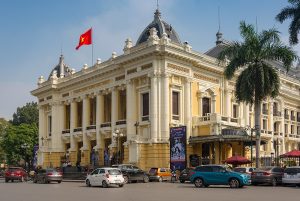The Hanoi Opera House, a French government initiative at the turn of the 20th century, underwent construction from 1901 to 1911. The site, previously a wetland area belonging to Thach Tan and Tay Luong villages in the Phuc Lan – Tho Xuong District, was chosen following a city council meeting chaired by Richard, Hanoi’s envoy, in 1899.
The architectural project, designed by Harlay and Broyer, faced modifications based on input from various architects. Commencing on June 7, 1901, under the technical supervision of architect Harlay, the construction involved substantial efforts, employing 300 workers daily. The embankment utilized 35,000 bamboo poles and 90cm thick concrete blocks, with over 12,000m3 of materials, nearly 600 tons of iron and steel, and a construction area of 2600m2. The façade featured a grand staircase overlooking what is now August Revolution Square.
Inspired by ancient Greek architecture, Tuileries Castle, and the Paris Opera House, the interior boasted a spacious stage, a main auditorium with leather and velvet-covered seats, individual ticket rooms, and administrative spaces. The funding for this grand theater amounted to 2,000,000 French Francs.
Initially reserved for the upper classes and a few wealthy Vietnamese, the Hanoi Opera House hosted classical art performances, such as opera and drama, four times a week. Its historical significance extends to the August Revolution and the early years of Vietnam Democratic Republic, witnessing key events such as the introduction of the Viet Minh Front and the Southern Resistance Day.
However, after nearly a century of use, the Opera House has experienced significant degradation. Both its interior and exterior require comprehensive upgrades to meet international standards for shows and maintain its status as a cultural hub. Despite its current state, the Hanoi Opera House remains a unique and valuable structure, contributing to the cultural landscape of Hanoi and Southeast Asia, serving as a crucial center for artistic performances, meetings, and conferences.






